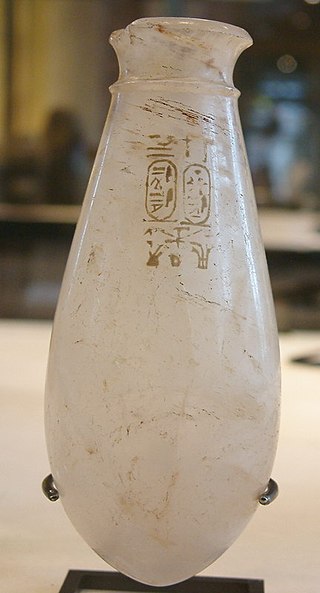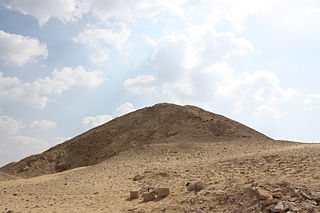Related Research Articles

Unas or Wenis, also spelled Unis, was a pharaoh, the ninth and last ruler of the Fifth Dynasty of Egypt during the Old Kingdom. Unas reigned for 15 to 30 years in the mid-24th century BC, succeeding Djedkare Isesi, who might have been his father.
Teti, less commonly known as Othoes, sometimes also Tata, Atat, or Athath in outdated sources, was the first king of the Sixth Dynasty of Egypt. He was buried at Saqqara. The exact length of his reign has been destroyed on the Turin King List but is believed to have been about 12 years.

Pepi II Neferkare was a pharaoh of the Sixth Dynasty in Egypt's Old Kingdom who reigned from c. 2278 BC. His second name, Neferkare (Nefer-ka-Re), means "Beautiful is the Ka of Re". He succeeded to the throne at age six, after the death of Merenre I.

Userkare was the second pharaoh of the Sixth Dynasty of Egypt, reigning briefly, 1 to 5 years, in the late 24th to early 23rd century BC. Userkare's relation to his predecessor Teti and successor Pepi I is unknown and his reign remains enigmatic.

Pepi I Meryre was an ancient Egyptian pharaoh, third king of the Sixth Dynasty of Egypt, who ruled for over 40 years at the turn of the 24th and 23rd centuries BC, toward the end of the Old Kingdom period. He was the son of Teti, the founder of the dynasty, and ascended the throne only after the brief intervening reign of the shadowy Userkare. His mother was Iput, who may have been a daughter of Unas, the final ruler of the preceding Fifth Dynasty. Pepi I, who had at least six consorts, was succeeded by his son Merenre Nemtyemsaf I, with whom he may have shared power in a coregency at the very end of his reign. Pepi II Neferkare, who might also have been Pepi I's son, succeeded Merenre.

The Sixth Dynasty of ancient Egypt, along with the Third, Fourth and Fifth Dynasty, constitutes the Old Kingdom of Dynastic Egypt.

The Twenty-third Dynasty of Egypt is usually classified as the third dynasty of the ancient Egyptian Third Intermediate Period. This dynasty consisted of a number of Meshwesh kings, who ruled either as pharaohs or as independent kings of parts of Upper Egypt from 880 BC to 720 BC, and pharaohs from 837 BC to 728 BC.
Qift is a small town in the Qena Governorate of Egypt about 43 km (27 mi) north of Luxor, situated a little south of latitude 26° north, on the east bank of the Nile. In ancient times its proximity to the Red Sea made it an important trading emporium between India, Punt, Felix Arabia and the North. It was important for nearby gold and quartzite mines in the Eastern Desert, and as a starting point for expeditions to Punt.

The pyramid of Teti is a smooth-sided pyramid situated in the pyramid field at Saqqara in Egypt. It is the second known pyramid containing pyramid texts. Excavations have revealed a satellite pyramid, two pyramids of queens accompanied by cult structures, and a funerary temple. The pyramid was opened by Gaston Maspero in 1882 and the complex explored during several campaigns ranging from 1907 to 1965. It was originally called Teti's Places Are Enduring. The preservation above ground is very poor, and it now resembles a small hill. Below ground the chambers and corridors are very well preserved.

The South Saqqara Stone is the lid of the sarcophagus of the ancient Egyptian queen Ankhenespepi, which was inscribed with a list for the reigns of the pharaohs of the 6th Dynasty from Teti, Userkare, Pepi I, Merenre to the early years of Pepi II under whom the document was likely created. It is essentially an annal document which records events in each year of a king's reign; unfortunately, it was reused in antiquity for Ankhesenpepi I's burial and many of its invaluable inscriptions have been erased.

Ahhotep I was an ancient Egyptian queen who lived circa 1560–1530 BC, during the end of the Seventeenth Dynasty of Egypt. She was the daughter of Queen Tetisheri and Senakhtenre Ahmose, and was probably the sister, as well as the queen consort, of Pharaoh Seqenenre Tao ll. Ahhotep I had a long and influential life. She ruled as regent for her son Ahmose I for a time.
Iput I was a Queen of Egypt, a daughter of King Unas, the last king of the Fifth Dynasty of Egypt. She married Teti, the first Pharaoh of the Sixth Dynasty of Egypt. Their son was Pepi I Meryre. She possibly ruled as regent for her son Pepi I.
Sesheshet, occasionally known as Sesh, was the mother of King Teti, the first and founding pharaoh of the Sixth Dynasty of Ancient Egypt. She was instrumental in enabling her son to gain the throne and reconciling two warring factions of the royal family.
Iput was an ancient Egyptian queen consort of the Sixth Dynasty, a sister and wife of Pepi II.
Khuit II was a wife of King Teti, the first pharaoh of the Sixth Dynasty of Egypt.

The High Priest of Ptah was sometimes referred to as "the Greatest of the Directors of Craftsmanship". This title refers to Ptah as the patron god of the craftsmen.
Khenthap was allegedly a queen of Ancient Egypt. She is said to have lived during the 1st Dynasty. Her historical figure is very obscure, since there are no contemporary sources for her name. She appears only once in a much later inscription.
Merefnebef, also called Unisankh and Fefi, was a vizier from the Sixth Dynasty of Egypt. He first served at the court of Teti, possibly became vizier during the reign of Userkare, and was dismissed during the reign of Pepi I.

The Eighteenth Dynasty of Egypt is classified as the first dynasty of the New Kingdom of Egypt, the era in which ancient Egypt achieved the peak of its power. The Eighteenth Dynasty spanned the period from 1550/1549 to 1292 BC. This dynasty is also known as the Thutmosid Dynasty for the four pharaohs named Thutmose.
Mehu was an Ancient Egyptian vizier who lived in the Sixth Dynasty, around 2300 BC. The office of the vizier was the most important one at the royal court. Mehu is mainly known from his monumental mastaba at Saqqara, not far away from the Pyramid of Unas.
References
- ↑ Miroslav Bárta, Jaromír Krejčí. Abusir and Saqqara in the Year 2000.
- ↑ Naguib Kanawati, Conspiracies in the Egyptian Palace: Unis to Pepy I
- ↑ Zahi Hawass. Silent Images: Women in Pharanoic Egypt.
- ↑ Amarna and the 6th Dynasty